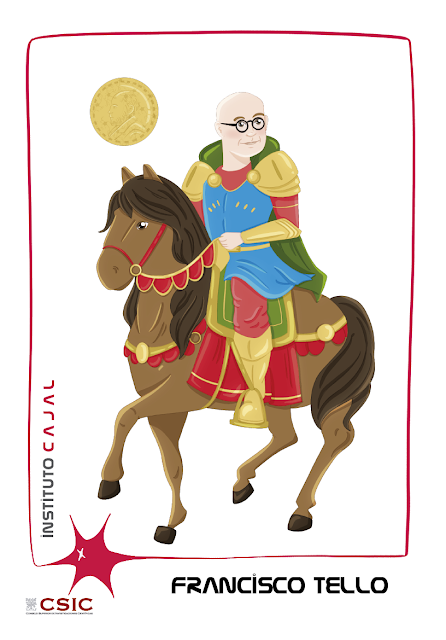HORSE OF GOLD
FRANCISCO TELLO
FRANCISCO TELLO (1880 – 1958), the father of pathological anatomy in Spain

Francisco Tello is the rider of the Horse of gold. From the first student hired by the Biological Research Laboratory at the beginning of the century to a trusted man and successor of Don Santiago at the Cajal Institute, he had a brilliant career as an anatomopathologist, cut short by the shadows of the Civil War:
“He is the best of my disciples and the most qualified and dissertated of Spanish bacteriologists” Santiago Ramón y Cajal
Jorge Francisco Tello y Muñoz was born in Alhama de Aragón (Zaragoza) on April 23, 1880 and already at the time of graduating in Medicine in Madrid he stood out, obtaining the Extraordinary Prize.
Although his first steps as a doctor were taken in the field of surgery under the guidance of José Ribera y Sans, he very soon surrendered to the charms of histology, and his enthusiasm for this discipline led him to buy a microscope with his savings to Continue investigating at home. Like Cajal!
Aragonese, doctor and histologist, destiny could only lead him to form an exceptional tandem with the great teacher Santiago Ramón y Cajal, who quickly realized his capacity for work, dedication and vocation.
It can be said that he was the first genuine student of the Cajalian school since in 1902 he was hired at the newly created (1901) Biological Research Laboratory. From then on, his career continued inextricably and faithfully linked to that of his teacher Cajal: appointed interim assistant professor of Histology and Pathological Anatomy at the Faculty of San Carlos in 1905, and permanent assistant professor in 1910, he combined his teaching with his work. as an assistant (since 1907) in the Biological Research Laboratory. As a neurohistologist he was one of the best defenders of neuronism against reticularism, he worked on the processes of degeneration and regeneration of the nervous system (one of the great themes of the Cajal school) and defended neurotropism.
Encouraged by Cajal to deepen his training abroad, he went to Berlin in 1911 with a scholarship from the Board of Expansion of Studies, where he worked at the Koch Institute dedicated to the study of infectious diseases, while at the same time he trained in pathological anatomy at the Moabit Hospital. with Clemens Ernst Benda (a German pathologist who made important contributions to the study of Down syndrome a couple of decades before Jérôme Lejeune discovered the chromosomal origin of the disease in 1959).
Upon returning to Madrid in 1912, he resumed his work at the Chair and with Cajal, combining it with his new responsibility as Head of the Epidemiology Section of the Alfonso bacteriology led Francisco Tello to open the Cajal School to the study of the pathology of the nervous system.
His life was closely linked to Cajal, who always trusted him, as his first and most faithful disciple and who accompanied him for the longest years in his life (from the beginning of the century until his death in 1934). Deputy director of the Cajal Institute since 1922, he was logically named Cajal’s successor in 1934.
His appointment (in 1923) as a medical academic was not the only recognition that Tello received throughout his life, because in addition to his neurohistology work with Cajal, in his 30 years at the head of the Alfonso XIII National Institute of Hygiene he completely renewed Spanish healthcare. He is one of the men who has done the most for the health of Spaniards and for Spanish science in general, despite the fact that for the majority of Spaniards he is largely unknown.
Greatly passionate about laboratory work, teaching, publications and the microscope that he had in his house, it is not surprising that he is the author of 54 research articles and several books, such as the Manual of Pathological Anatomy that he wrote. with Cajal.
Tello stands out for his ability to create a school in the field not only of histology but also in that of pathological anatomy. Although the figure of Cajal weighed heavily on him, he was able to bring together a large group of collaborators until he created the first Spanish school of anatomopathologists.
Among his many disciples, Jorge Ramón Fañanás (Cajal’s son) and Fernando de Castro Rodríguez stood out, among others, who would become, along with Tello, one of Cajal’s closest disciples.
Once the civil war broke out, Tello was confirmed in his position as director of the Cajal Institute, while in 1937 he was named dean of the Faculty of Medicine. He therefore remained in Madrid, where together with Fernando de Castro Rodríguez he was in charge of safeguarding Cajal’s legacy. At the end of the war he was subjected to a purge file that separated him from research until 1945, almost coinciding with his retirement and with a vision problem that permanently separated him from research until he died in Madrid, on November 28, 1958. .
Fernando de Castro S, scientist at the Cajal Institute, talks to us about Francisco Tello in the program “On the shoulders of Giants”, by Manuel Seara. He discovers the podcast and a video where you will learn with Fernando a lot about Cajal’s disciples… and many more things about Francisco Tello in this interactive infographic:
Have you been curious and want to know more?
Sources about his biography:
Spanish Society of Neuroscience (SENC): “Meet the neuroscientists who have made history” Jorge Francisco Tello: https://www.senc.es/wp-content/uploads/2017/11/biografia-Jorge-Francisco-Tello. pdf
Royal Academy of History: Electronic Biographical Dictionary (DB-e), entry Jorge Francisco Tello y Muñoz https://dbe.rah.es/biografias/8585/jorge-francisco-tello-y-munoz, by Manuel Díaz-Rubio Garcia.
